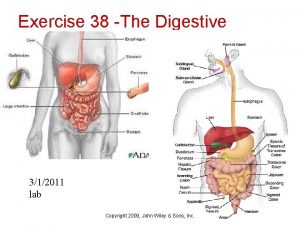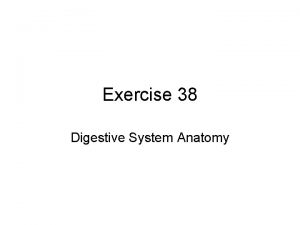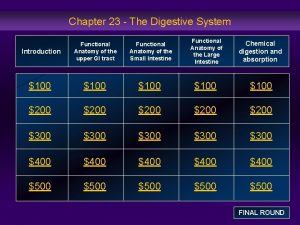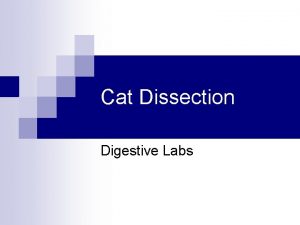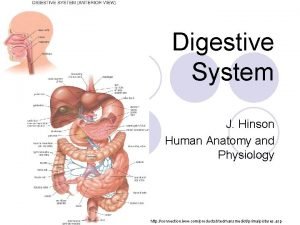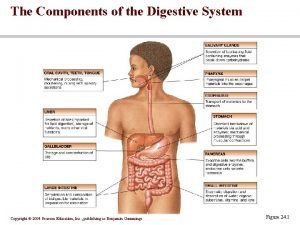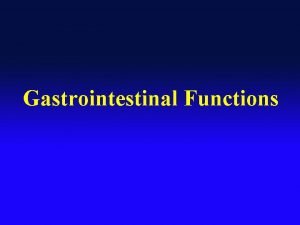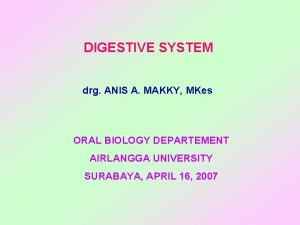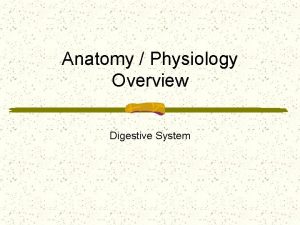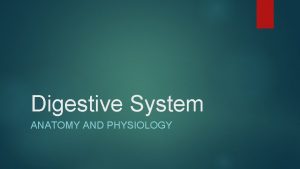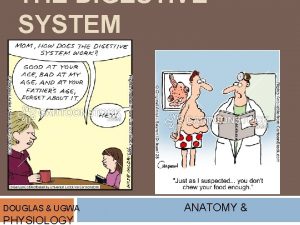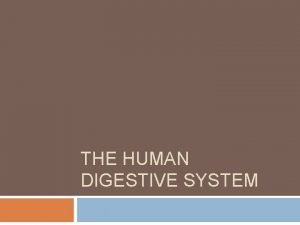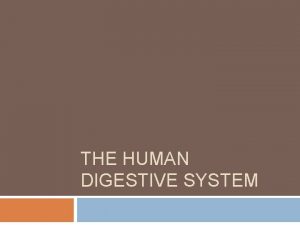Digestive System J Hinson Human Anatomy and Physiology




































- Slides: 36

Digestive System J. Hinson Human Anatomy and Physiology http: //connection. lww. com/products/stedmansmedict/primalpictures. asp

I. Introduction A. Digestion B. Includes 1. Alimentary Canal (aliment/o = nourish) : mouth, pharynx, esophagus, stomach, small intestine, large intestine 2. Accessory Organs: salivary glands, liver, gallbladder, pancreas http: //wps. prenhall. com/wps/media/objects/488/500694/CDA 40_1. jpg

II. The Alimentary Canal A. Muscular tube ~ 9 m B. Tissues 1. Mucosa a. Glands secrete b. Functions: protection, absorption and secretion 2. Submucosa a. Contains blood vessels, lymphatic vessels, and nerves b. Nourishes

II. The Alimentary Canal B. Tissues 3. Muscular a. circular smooth muscle controls diameter; longitudinal controls length 4. Serosa a. visceral peritoneum b. contains serous fluid C. Movements: mixing or propelling - peristalsis http: //medsci. indiana. edu/c 602 web/602/c 602 web/scans/19 f. jpg

III. Oral Cavity A. Mouth (or/o): mechanical digestion B. Cheeks (bucc/o): muscular for expression and chewing C. Lips (cheil/o): movement and sensation; color from blood vessels

III. Oral Cavity D. Tongue (lingu/o; gloss/o): mixes food w/ saliva 1. Connects via frenulum 2. Papillae contain taste buds (bitter, sweet, sour, salty) http: //content. answers. com/main/content/img/gale. Neurology/gend_01 _img 0040. jpg http: //health. yahoo. com/media/healthwise/n 5551320. jpg

III. Oral Cavity E. Palate (palat/o) 1. anterior – hard posterior – soft projection is the uvula (uvul/o) 2. palatine tonsils – lateral 3. pharyngeal (pharyg/o) tonsils - posterior http: //biology. clc. uc. edu/fankhauser/Labs/ Microbiology/Strep_Detection/oropharynx _P 2253089_lbd. JPG

III. Oral Cavity F. Teeth (dent/i; dont/o; odont/o) 1. 20 primary (deciduous); 32 secondary (permanent) 2. increase surface area 3. Types: a. incisor (front) b. cuspids (canines) c. bicuspids d. molars 4. Consists of: crown, root, enamel, dentin, pulp 5. peridontal ligament attaches http: //www. dentalgentlecare. com/_derived/tooth_anatomy. htm_txt_Tooth 2. gif

Teeth

IV. Pharynx (pharyng/o) A. Cavity behind mouth (aka – throat) 1. Nasophar ynx 2. Oropharyn x 3. Laryngopharynx http: //www. levelfive. com/ZINA/IMAGES/Anatomical/pharynx. jpg

V. Swallowing A. Three Stages http: //greenfield. fortunecity. com/rattler/46/upali 4. htm 1. Food is mixed with saliva; forms a bolus; forced into the phayrnx – voluntarily initiated! 2. Involuntary reflex moves food to esophagus; epiglottis (skin flap) closes 3. Food to stomach via peristalsis.

VI. Esophagus (esophag/o) A. Collapsible tube ~ 25 cm 1. Penetrates diaphragm B. Circular smooth muscle http: //home. hawaii. rr. com/dochazenfield/images/esophagus%20 B. jpg

VII. Stomach (gastr/o) A. General Info 1. J-shaped, pouch-like, organ in upper L abdomen 2. Holds ~ 1 L 3. Folded rugae 4. Mixes bolus w/ HCl and gastric juice to become chyme http: //www. sciencebob. com/lab/bodyzone/stomach. gif

VII. Stomach B. Regions 1. Cardiac 2. Fundus 3. Body 4. Antrum http: //training. seer. cancer. gov/module_anatomy/images/illu_stomach. jpg 5. Pyloric a. Pyloric sphincter prevents regurgitation

VII. Stomach C. Gastric Secretions 1. Glands secrete juice a. Goblet – mucus b. Chief – enzymes c. Parietal – HCl Acid 2. Gastric Juice 3. Regulated by gastrin 4. food inhibits secretion D. Begin protein digestion; Some absorption: H 20, glucose, salts, alcohol, lipid-soluble drugs http: //intmed. muhealth. org/gast/images/stomach. gif

Component Source Function Chief cells Inactive form of pepsin Formed from pepsinogen when mixed with HCl Protein-splitting enzymes Parietal cells Changes pepsinogen to pepsin; gives acidic environment for pepsin Goblet cells; mucous glands Provides viscous, alkaline protective layer on stomach wall Parietal cells Aids in B 12 absorption Pepsinogen Pepsin Hydrochloric Acid Mucus Intrinsic Factor

VIII. Small Intestine (enter/o) A. Extends from pyloric sphincter to LI B. Functions: 1. Receive secretions 2. Completes digestion in chyme 3. Absorbs nutrients 4. Transports wastes to LI http: //www. exn. ca/news/images/1999/02/01/19990201 -smallintestine. jpg

VIII. Small Intestine C. 3 portions 1. Duodenu m 2. Jejunum 3. Ileum a. Mesentery suspends

VII. Small Intestine D. Secretions 1. Include mucus and enzymes 2. Split macromolecules a. Peptidases: proteins to amino acids a. Sucrase/maltase/lactase: disaccharides to monosaccharides b. Lipase: lipids to fatty acids and glycerol 3. Enhanced by gastric juices, chyme, and distension http: //bio. bd. psu. edu/cat/Circula tory_System/vesels%20 of%20 s mall%20 intestine. jpg

VII. Small Intestine E. Absorption 1. Villi increase SA 2. Monomers absorbed via diffusion or active transport 3. Also water and electrolytes 4. Malabsorption a. Bile problems; Celiac disease – gluten reaction b. Sxs: weakness, etc. http: //publications. royalcanin. com/images/2/2343/p 7_image. gif

IX. Large Intestine (col/o) A. ~ 5 feet a. Cecum a. Appendix b. Colon (i) Ascending (ii)Transverse (iii)Descending (iv)Sigmoid

IX. Large Intestine A. 1. c. Rectum: ~ 5 cm d. Anal canal: ~ 2 -3 cm (i) anus (a) internal (b) external (ii) hemorrhoids http: //www. nutrigenesis. com/page_images/hemorrhoids. jpg

IX. Large Intestine C. Functions 1. no digestive function 2. mucus secretions 3. absorbs water and electrolytes 4. forms, stores, and expels feces

http: //mi 2 mm 00. eng. shizuoka. ac. jp/ matsumaru 2/research/21 cvalsalva. jpg IX. Large Intestine D. Movement 1. Mixing and peristalsis 2. 2 -3 movements daily 3. Defecation (initiated by distension) a. valsalva maneuver E. Feces 1. Composition: 75% water, undigested material, mucus, & bacteria 2. bile salts

Ostomy http: //www. youtube. com/w atch? v=k. Uv. HDdj. ZJkc Colonoscopy http: //www. youtube. com/w atch? v=rl 4 s 1 D 4 MGH 8 http: //www. dhmc. org/dhmc-internet-upload/file_collection/colonscopy. jpg

Digestive System Accessory Organs

X. Salivary (sial/o) Glands A. Function of fluids: 3 1. 2. 3. 4. Moisten food particles Bind Dissolve carbs Dissolve chemicals for taste 5. Cleansing B. Cells: 3 1 2 1. Serous – secrete salivary amylase to break down carbs 2. Mucous – mucus to bind and lubricate http: //www. salivary-glands-disease. com/assets/images/img. SGDcauses. jpg

XI. Liver (Hepat/o) http: //www. livercancer. com/images/anterior. liver. gif A. Below diaphragm B. Functions: 1. Metabolism of macromolecules 2. Storage – vitamins A, D, B 12 3. Filtering blood 4. Destruction of toxins (alcohol) 5. Secretion of bile

IX. Liver C. Structure 1. Reddish-brown color 2. Lobes a. Separated into hepatic lobules 3. Hepatic ducts carry bile a. Common bile duct (cholagi/o) formed by merging http: //www. liverdoctor. com/images/detox_pathways. jpg

IX. Liver http: //www. pathguy. com/l ectures/fatty_liver. jpg D. Bile (chol/e, o) 1. Secreted by hepatic cells 2. Contains bile salts, pigments, etc. a. bile salts digest http: //www. pathguy. com/lectures/liver. htm

XII. Gallbladder (cholecyst/o) http: //www. lbah. com/images/liver/gallbladder. jpg A. Attached to liver by cystic duct B. Functions: 1. Stores bile 2. Concentrates bile 3. Release bile 4. Lipid

X. Gallbladder C. Common Bile Duct = cystic + hepatic ducts D. Gallstones = choleliths! http: //www. emedicine. com/med/images/1226 gs 1. jpg http: //images. medicinenet. com/images/illustrations/stomach. jpg

XIII. Pancreas (pancreat/o) A. Both endocrine and exocrine function B. Structure 1. Extends horizontally 2. Pancreatic duct and Bile duct from liver and gallbladder empties into duodenum http: //training. seer. cancer. gov/module_anatomy/images/illu_pancrease. jpg

XIII. Pancreas (pancreat/o) C. Pancreatic juice 1. Contains enzymes that can split carbs, proteins, fats, and nucleic acids Regulation 2. 1. 2. Secretin stimulates release of pancreatic juice high in bicarb. Cholecystokinin stimulates release of pancreatic juice high in digestive enzyme. http: //training. seer. cancer. gov/module_anatomy/images/illu_pancrease. jpg

VIII. Pancreas (pancreat/o) D. Islets of Langerhans (endocrine cells) secrete: 1. Insulin: stimulates body cells to take in glucose from the blood stream to decrease blood sugar levels a. Damage or underproduction: hyperglycemia and/or Diabetes Mellitus (DM) b. Overproduction: hypoglycemia 2. Glucagon: stimulates liver to release glucose to increase blood sugar levels

XIV. Clinical Terms A. B. C. D. E. F. G. H. Aphagia Cholecystitis Cirrhosis Diverticulitis Dyspepsia Gingivitis Hepatitis Diabetes http: //www. dental-health-index. com/images/Ging 1. jpg
 Holly hinson md
Holly hinson md Endomysium
Endomysium Waistline
Waistline Holes essential of human anatomy and physiology
Holes essential of human anatomy and physiology Distal and proximal
Distal and proximal Chapter 2 human reproductive anatomy and physiology
Chapter 2 human reproductive anatomy and physiology Human anatomy and physiology 10th edition
Human anatomy and physiology 10th edition Anatomy and physiology edition 9
Anatomy and physiology edition 9 Anatomy and physiology unit 7 cardiovascular system
Anatomy and physiology unit 7 cardiovascular system Types of respiration in human
Types of respiration in human Appendicular skeleton pectoral girdle
Appendicular skeleton pectoral girdle Digestive system circulatory system and respiratory system
Digestive system circulatory system and respiratory system Serves as a mixing chamber and holding reservoir
Serves as a mixing chamber and holding reservoir Exercise 38
Exercise 38 Functional anatomy of the digestive system
Functional anatomy of the digestive system Ileocecal junction cat
Ileocecal junction cat Mucus c
Mucus c Intestine
Intestine Emulsification
Emulsification Digestive physiology ppt
Digestive physiology ppt Upper and lower airway
Upper and lower airway Tattoo anatomy and physiology
Tattoo anatomy and physiology International anatomy olympiad
International anatomy olympiad Structure anatomy and physiology in agriculture
Structure anatomy and physiology in agriculture Anatomy and physiology of bone
Anatomy and physiology of bone Pud triple therapy
Pud triple therapy Segmental anatomy of the liver
Segmental anatomy of the liver Difference between anatomy and physiology
Difference between anatomy and physiology Epigastric vs hypogastric
Epigastric vs hypogastric Rbc anatomy and physiology
Rbc anatomy and physiology The central sulcus divides which two lobes? (figure 14-13)
The central sulcus divides which two lobes? (figure 14-13) Http://anatomy and physiology
Http://anatomy and physiology Physiology of appendix
Physiology of appendix Aohs foundations of anatomy and physiology 1
Aohs foundations of anatomy and physiology 1 Aohs foundations of anatomy and physiology 2
Aohs foundations of anatomy and physiology 2 Anatomy and physiology of swine
Anatomy and physiology of swine Anatomy and physiology chapter 8 special senses
Anatomy and physiology chapter 8 special senses












